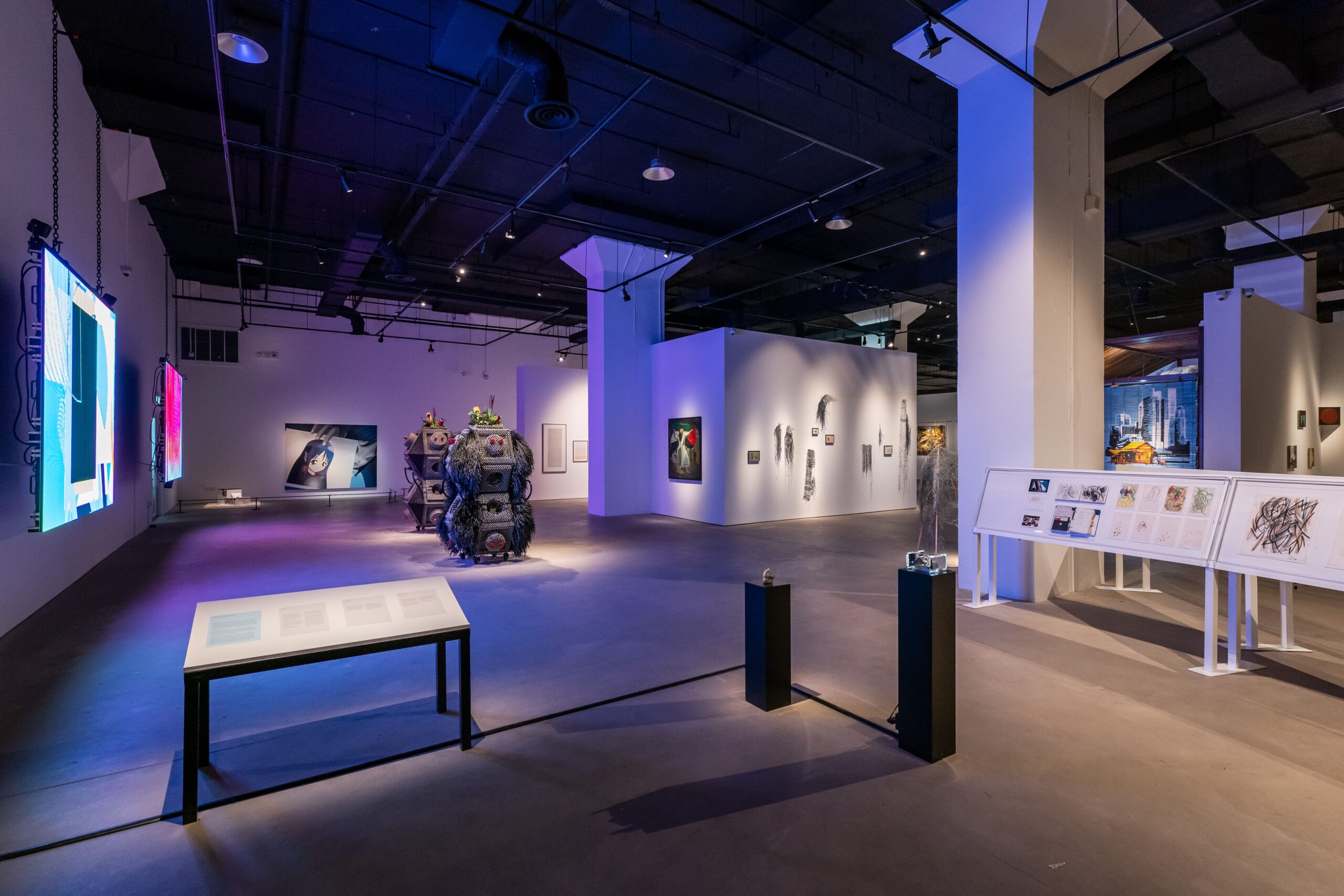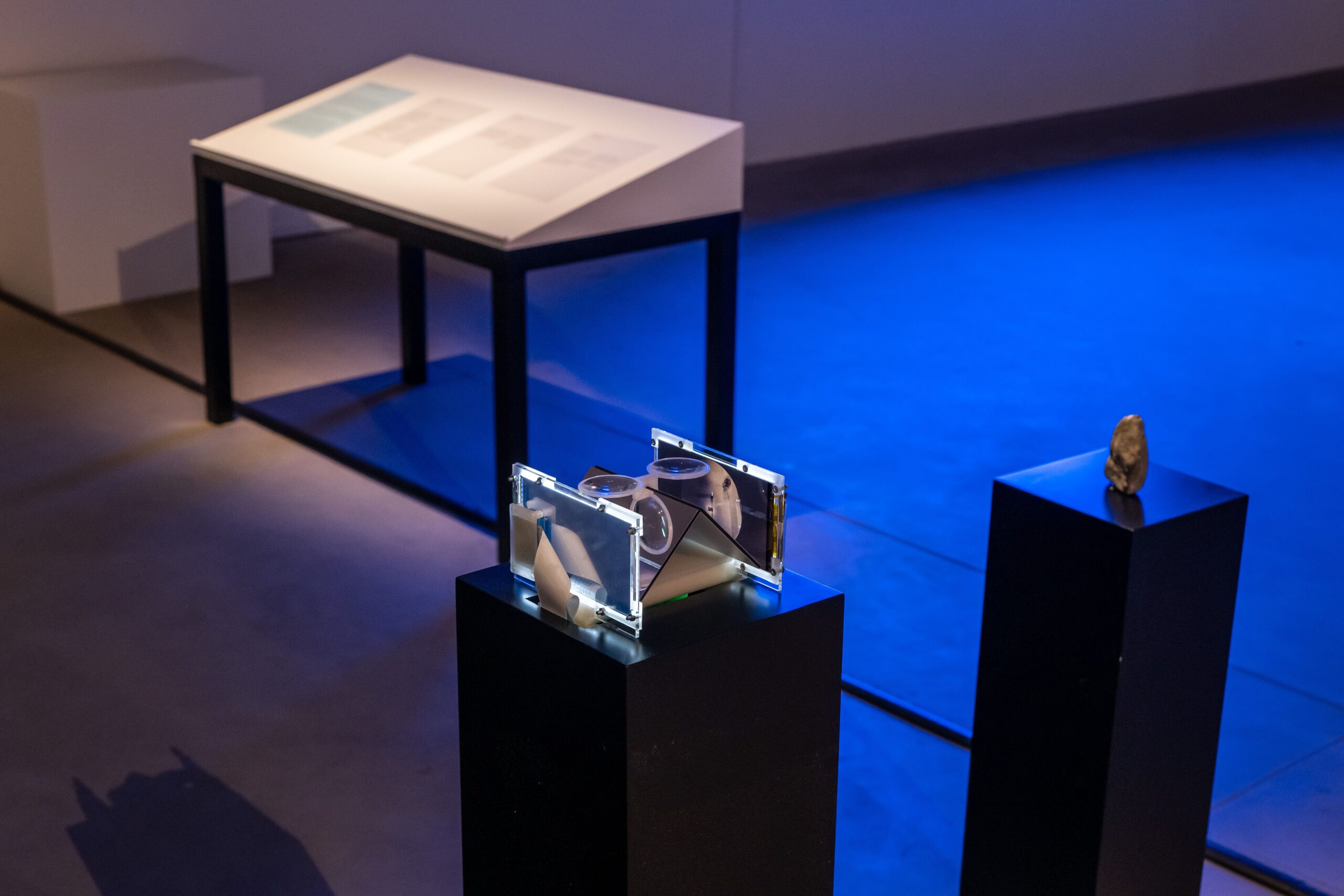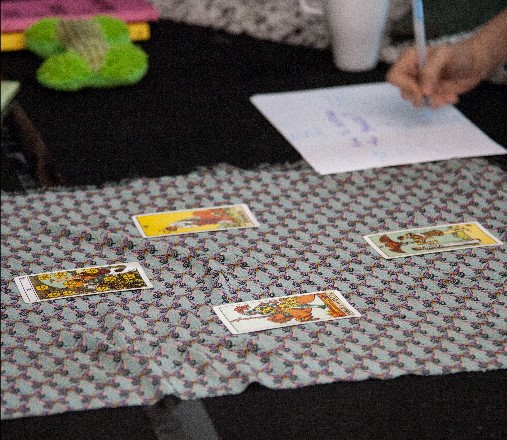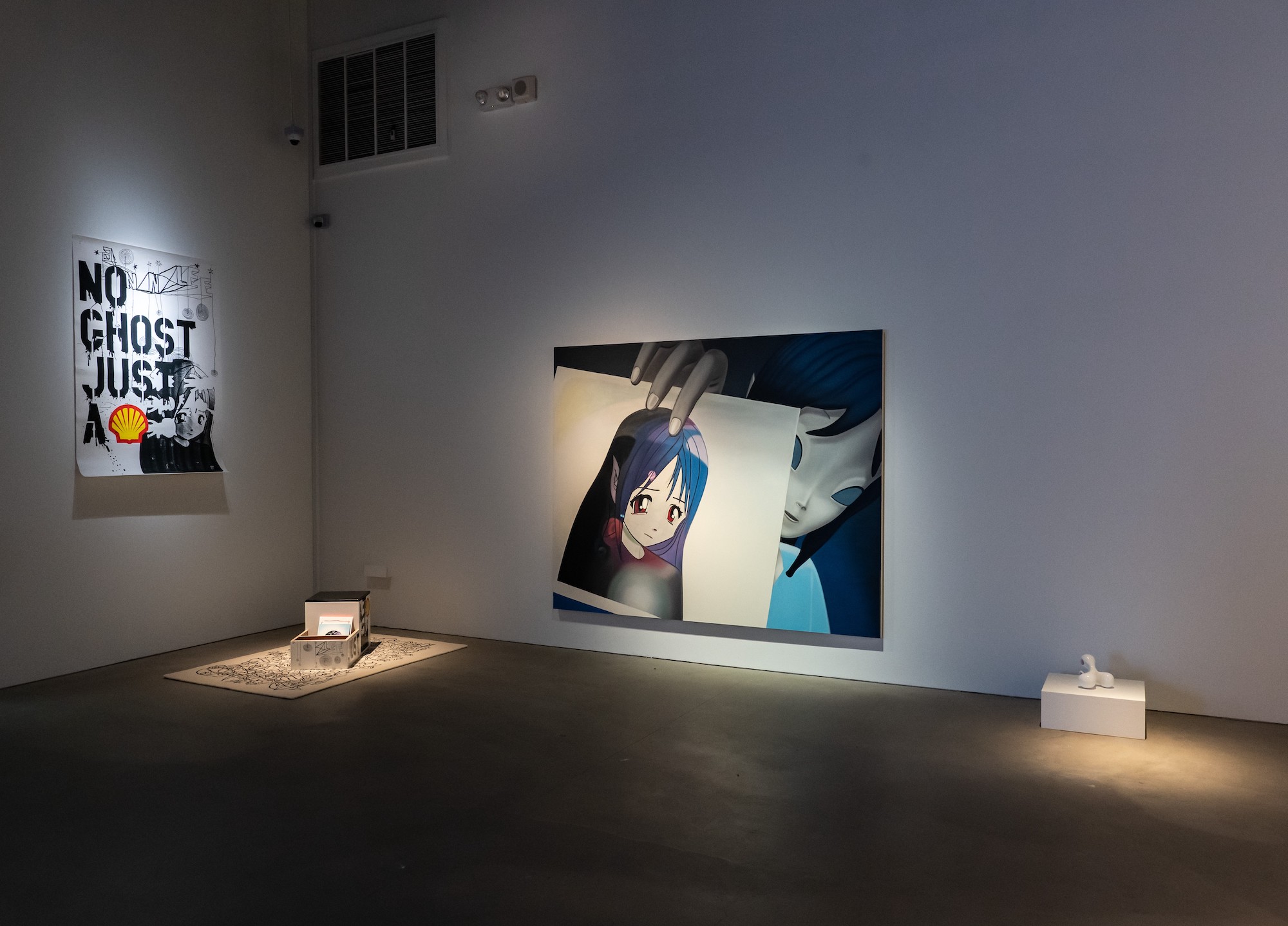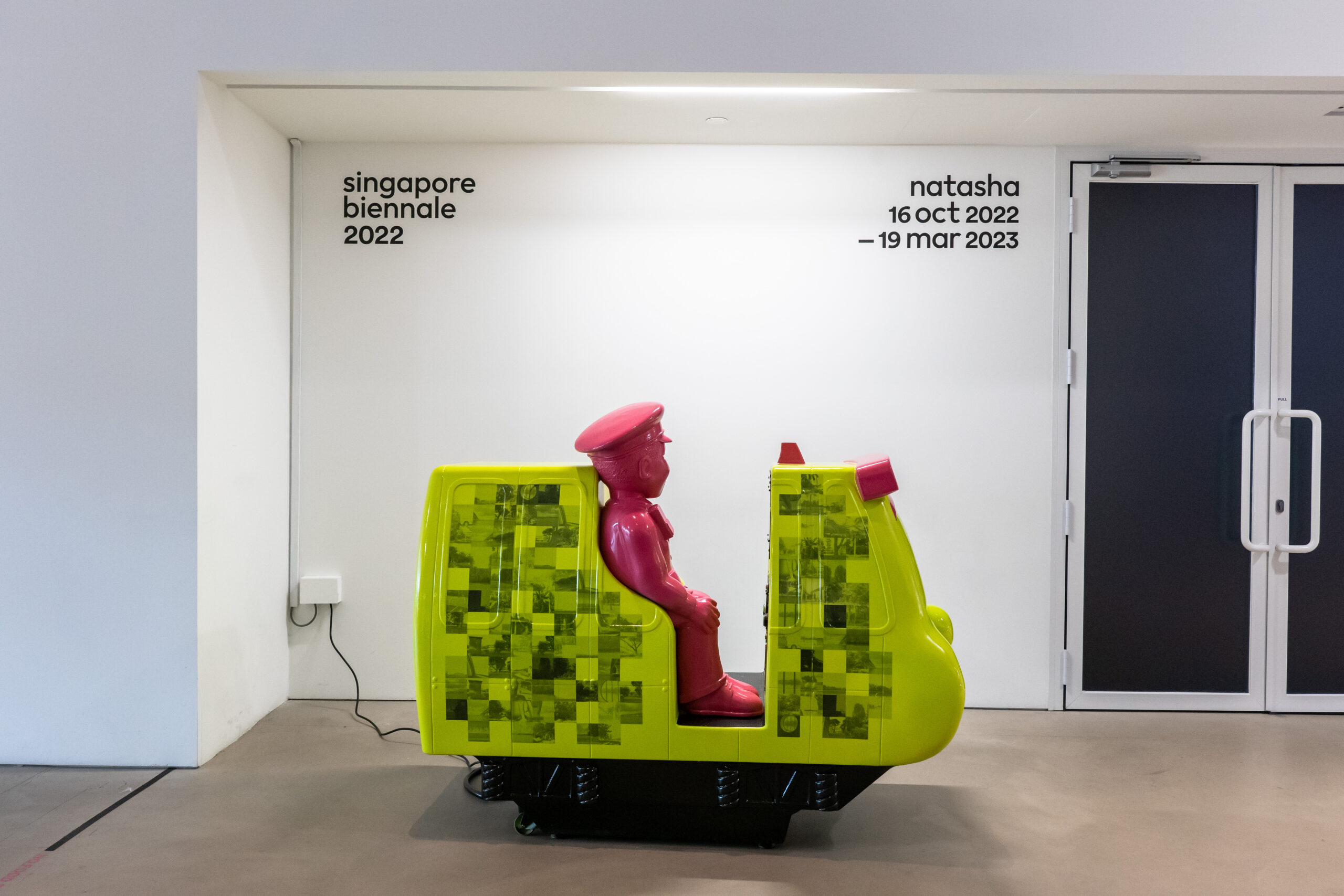
AWKNDAFFR, Get to the point, 2022, Video, Single channel, sound; vinyl, paint and clear gloss on modified coin-operated machine, 5 minutes [image courtesy of the artists and Singapore Biennale, Singapore]
Singapore Biennale: Natasha
Share:
Naming a biennale after a random, anonymous person felt like a gamble, and from the mutterings I heard on the ground in Singapore—among them, the repeated question, “Who is Natasha?”—it seemed that the gesture’s intention may not have translated for the 2022 Singapore Biennale. But then I saw the show, which was co-curated by Binna Choi (who was recently announced as co-curator of the Hawai’i Triennial in 2025), writer and curator Nida Ghouse, artist and researcher Ala Younis, and June Yap, director of curatorial and collections at Singapore Art Museum (SAM).
Spread across 11 locations, the bulk of the exhibition unfolds at SAM’s new location in the Tanjong Pagar Distripark (TPD), a site that, like Natasha’s opaque title, feels quite inaccessible. The Tanjong Pagar port area is where Southeast Asia’s first container terminal opened in 1972. SAM launched its TPD location in 2022, ahead of the 2027 expiration of the port’s lease and the relocation of its terminals to a development at Tuas. SAM’s TPD location is positioned as a driving force behind a developing arts and culture cluster, which has been conceived, per Culture Minister Edwin Tong, as part of SAM’s “disappearing museum concept.” All of which kind of feels like a clever reframing of delays to the reopening of SAM’s two existing buildings in central Singapore, both of which have been closed since 2019 for redevelopment—or like a branding tool to help elevate what remains a sparse site that’s quite hard to navigate.
Singapore Biennale: Natasha, installation view, 2022 [image courtesy of the artists and Singapore Biennale, Singapore]
With that stated, the conceptual branding of SAM at TPD works as a projection to imagine what’s possible, which loops back to Natasha and what it all means. At SAM, where the exhibition occupies levels one and three of a vast warehouse, one project in particular offers an elastic coda through which to read the entire show. Tales in Stone: In Search of the Language of Primordial Paradise—conceived in collaboration with Koon Kwon, Kyoungtae Kim, Maya West, mediabus (Lim Kyung Yong), Min & Sulki, and Sungeun Lee—is a Singapore Biennale commission based upon 41 stones from the collection of Shim Beomsum. A scholar of modern Korean literature, Shim conceives of the collection’s objects as stone tablets and “portable petroglyphs.” Although they appear natural, Shim considers the stones’ markings to be writings that tell the story of creation. As he writes, in one wall text, “It is the duty of mankind to rise to the call of this original tongue.”
On level one, an optical device created by Sungeun Lee introduces the project. Positioned on a plinth, located next to another that displays a small gray stone, rests a clear box with a lens for viewers to look through, as if to observe a specimen within, only to reveal a bird’s–eye video stream that captures each viewer from above as they bend down to look into the device. On the wall, a text describes the human face as “the most basic symbol and articulation of all Stone-Tablets,” whose “expressions, looks, and contours” constitute “units of language.” The work thus invited people to open their minds to an exercise in reading by first connecting to something undeniably universal.
Shin Beomsun with Koon Kwon, Kyungtae Kim, Maya West, mediabus Min & Sulki, and Lee Sungeun, Tales in Stone: In Search of the Language of Primordial Paradise, 2022, mixed media installation, dimensions variable [image courtesy of the artists and Singapore Biennale, Singapore]
This prelude felt like a warm–up for viewing the large enigmatic painting nearby that depicts the gray stone, there rendered in grayscale with glowing white marks contrasted by a dramatic black background. The painting hung next to a small pencil sketch of that stone by Koon Kwon, who created drawings and paintings for the project, and a photograph of the stone by Kyoungtae Kim. Each image amplifies lines on the surface of the stone, which Shim has named Berigol Gyryffyn-Stroking Shyamyan Stone-Tablet, after where it was found (the banks of Berigol River) and the images Shim has deciphered—in this stone’s case, a shamanic figure who strokes the neck of a mythical animal.
Shim’s complex cosmology underscores the curators’ intentions in the context of an exhibition whose name comes without much explanation. Both gestures amplify the idea that art is a search for meaning more than it is the production of a frame. “Welcome to Natasha!” begins one curatorial note. “Singapore Biennale 2022 has been given a name to draw attention to the possibilities of new and different relations between you, the Biennale, artworks and artists.” That invitation emerges with clarity on level three at SAM, where the rest of Shim’s stone collection—along with drawings, photographs, texts, and paintings that engage different specimens and their markings—spreads out in a cavernous space punctuated at its center by Walid Raad’s Comrade leader, comrade leader, how nice to see you _II (2022). Raad’s single-channel looped video projection of a waterfall cascades down an enormous free-standing wall, at the bottom of which stand small black-and-white paper cut-outs depicting five world leaders—Brezhnev, Gorbachev, Reagan, Thatcher, and Mitterrand—who played a hand in Lebanon’s civil war.
Raad’s waterfall purportedly represents the “Fickle Falls,” which militias in Lebanon named and renamed after world leaders that supported them, but you can never be sure of what is fact or fiction in Raad’s work. A case in point is a second project by the artist, Better be watching the clouds (again) (2000/2017), a series of inkjet prints lining one wall nearby, depicting images of flowers whose petals have been augmented with the heads of world leaders, including Yasser Arafat and Jimmy Carter. The prints are described as a donation to the fictional Atlas Group; they were apparently made in 1992 by Fadwa Hassoun, a botanist who worked for the Lebanese military during the civil war to assign codenames to international political and military leaders according to local flora. Although the specificities of the story might be fake, its implications are far from false—history and politics consist of mandated facts, indecipherable truths, and outright lies, after all, and Raad’s work centers this instability to destabilize narratives that have been presented, if not solidified, as accurate, immutable information.
Raad’s provocation resonates across Natasha, which asks what it means to know differently, and how to sense otherwise. The Sensing Salon: Reading with Echo, a Singapore Biennale commission created by Valentina Desideri and Denise Ferreira da Silva, opened up space to explore these questions directly. A small reading area located behind Raad’s “Fickle Falls,” invites visitors to conduct tarot readings by using the poems of American writer Ai Ogawa as a guide. A wall text describes the act of reading as “a kind of imaging in which the intuition assembles non-sensuous similarities in an instant, to form an image,” and the image itself as something complex, which can “include multiple perspectives and contradictions.” The description circles back to the question of who or what Natasha is and connects to a response located next to the table where tarot readings unfold, in the form of Rirkrit Tiravanija’s (Ghost Reader C.H.) (2002).
Valentina Desideri & Denise Ferreira da Silva, The Sensing Salon: Reading with Echo, 2022, furniture, publications and posters, dimensions variable [image courtesy of the artists and Singapore Biennale, Singapore]
Tiravanija’s 8.5 hour video features Annlee, a manga character purchased by Pierre Huyghe and Philippe Parreno as part of the No Ghost Just a Shell project, wherein artists were invited to create their own works using the character. In Tiravanija’s treatment, Annlee reads Philp K. Dick’s iconic novel Do Androids Dream of Electric Sheep?, upon which Ridley Scott’s 1982 cinematic classic Blade Runner was based. The result is an open and closed loop, in which a real-life “replicant” retells the story of a replicant from a speculative future. The artwork-as-shell thus becomes the message, as with Shim’s stone tablets and the name “Natasha” itself, wherein meaning is a co-authoring produced from interactions between the known and the unknown.
Singapore Biennale: Natasha, installation view, 2022 [image courtesy of the artists and Singapore Biennale, Singapore]
I pull my tarot card. Ten of Swords. I’d asked what 2023 would bring for the world, because it all feels like a clusterfuck right now. The booklet provided by The Sensing Salon offers a succinct but fittingly open-ended interpretation: “Exaggerated drama. Yet there is the sun already rising in the background.”
Stephanie Bailey is an Art Papers contributing editor, global editor-at-large for Ocula Magazine, an editor for Art Basel Stories, and conversations curator and content advisor for Art Basel Hong Kong. Formerly the senior editor of Ibraaz, where she worked from 2012–2017, and director of the first BTEC-accredited foundation diploma in art and design in Greece from 2009-2012, Bailey has contributed to Artforum, Art Monthly, Art Review, dɪ’van: A Journal of Accounts, Spike, and Yishu: Journal of Contemporary Chinese Art, among others, and also edits for M+, the museum of visual culture in Hong Kong. She is currently working on a PhD at Birkbeck School of Law, University of London, exploring the historical and contemporary intersections between art and the pursuit of human rights.
